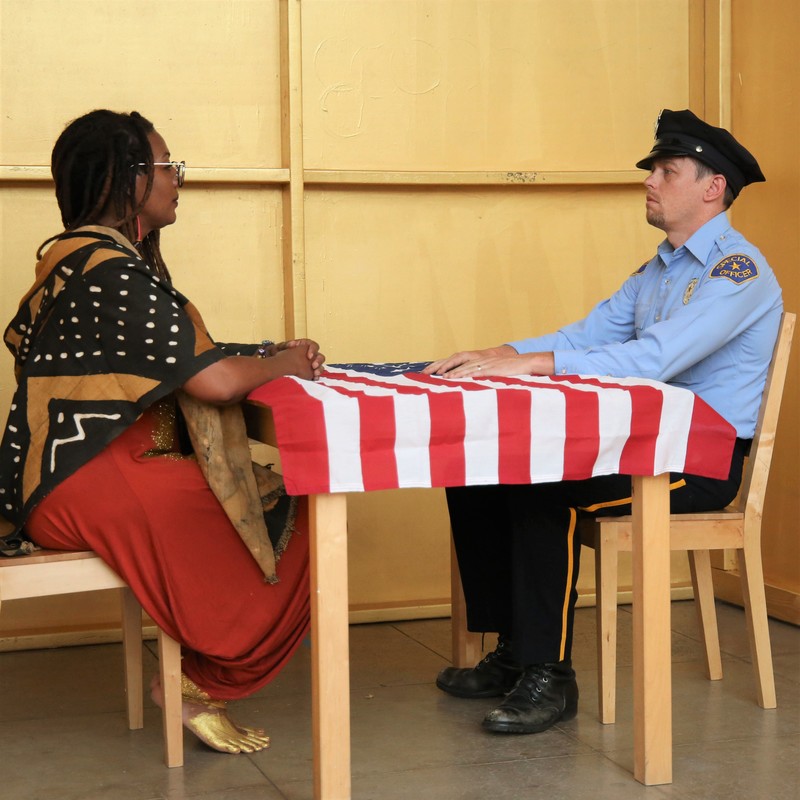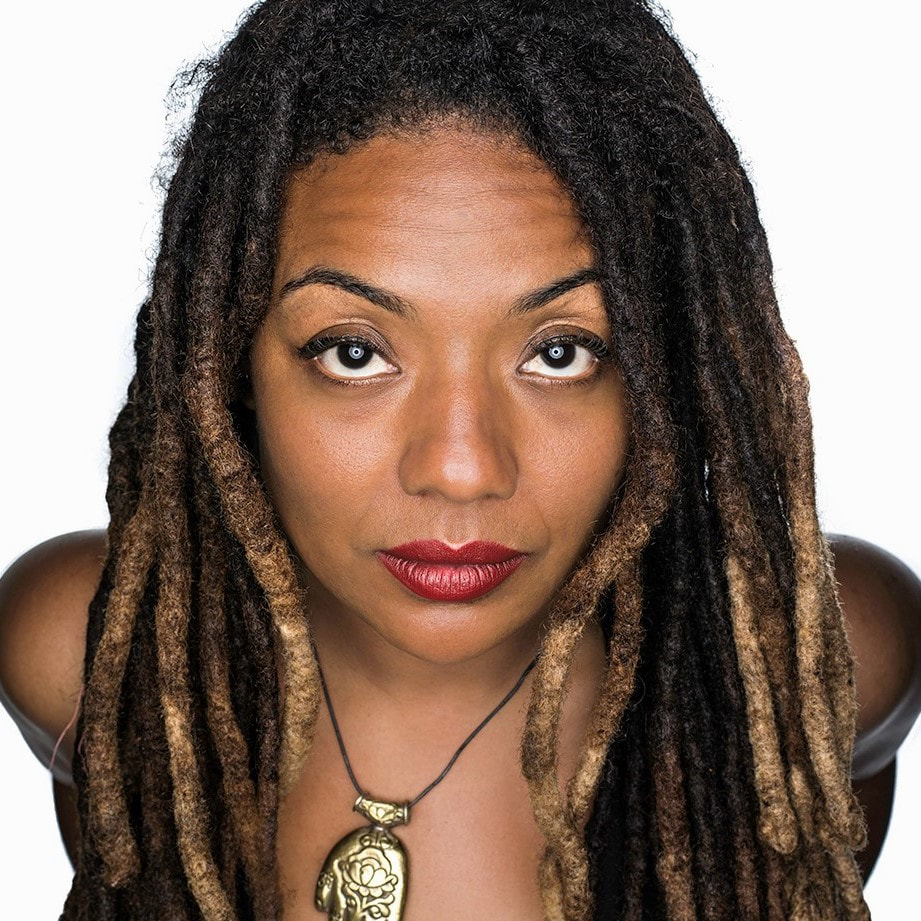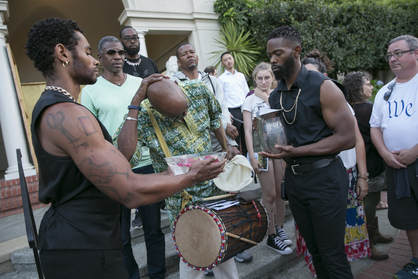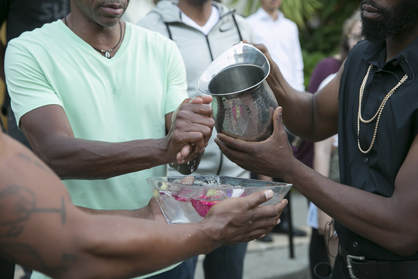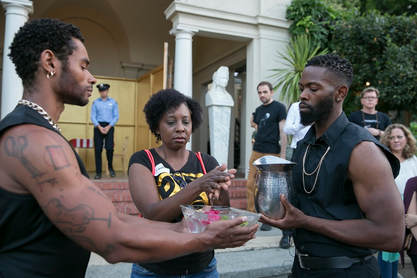By Margarita Kompelmakher, PhD
Photo (left, right): Jennifer Johns. LIV: A Ritual for Humanity. 2018 . ( 2018 Art on the Grounds: We the People )
Photo: David Gonzalez
Photo: David Gonzalez
In my third installment of interviews of artists at the Lucas Artists Programs working in performance, I interview singer-songwriter-performer Jennifer Johns before the premiere of her new performance work LIV: A Ritual For Humanity at the Art on the Grounds: We the People event in July 2018. One month later, we meet again to discuss how it went. Listen along in this before-and-after audio-blog journey as we discuss Johns’ courageous piece in which she builds a home for the history of police brutality in the US and “arrests” a police officer as part of a ritual for finding love and forgiveness.
BEFORE
“There’s hella more steps to loving than hate,” Johns professes. She describes her new performance artwork, LIV: A Ritual for Humanity , as a ritual grounded in the belief that love is a kind of work that society must undertake, rather than an individualized romantic feeling. In Johns’ diagnosis, the societal woes that this project uncovers—namely the history of blackness and police brutality in this country—is caused by a profound “fear of love.” The Oakland-based artist stages the act of finding love as a public performance in which she builds a house out of black-and-white images from FBI and police archives and “arrests” a police officer. She treats these actions as intentional steps in the process of her own personal healing and reckons with the traumatic history of state-sanctioned racial violence in this country.
During our chat in the library at the Lucas Artists Residency, Johns layers the terminology of recovery, art-making and social justice to describe the drive behind her artistic career. In this first audio clip, we discuss her early success in the music industry and the education she undertook to wield her talent for the benefit of humanity. Johns refuses to be pinned down by labels and artistic genres. Indeed, this distrust of categorical thinking runs deep as, later in the clip, she explains the imperative to resist compartmentalizing the contradictions in contemporary American society, where opportunity and wealth exist alongside structural racial and economic injustice. “To be in America you have to manage a certain level of cognitive dissonance,” she says. At the risk of being “crazy,” she explains why she is unable to perform this managing act in light of the police killings of (even more) black men in the past year. In Johns’ discussion, being “crazy” suggests a condition with a strong political connotation — a mental space from which she derives her new performance piece.
During our chat in the library at the Lucas Artists Residency, Johns layers the terminology of recovery, art-making and social justice to describe the drive behind her artistic career. In this first audio clip, we discuss her early success in the music industry and the education she undertook to wield her talent for the benefit of humanity. Johns refuses to be pinned down by labels and artistic genres. Indeed, this distrust of categorical thinking runs deep as, later in the clip, she explains the imperative to resist compartmentalizing the contradictions in contemporary American society, where opportunity and wealth exist alongside structural racial and economic injustice. “To be in America you have to manage a certain level of cognitive dissonance,” she says. At the risk of being “crazy,” she explains why she is unable to perform this managing act in light of the police killings of (even more) black men in the past year. In Johns’ discussion, being “crazy” suggests a condition with a strong political connotation — a mental space from which she derives her new performance piece.
Defying Expectations (11min 25sec)
Johns has been working on a new piece at the Lucas Artists Residency this spring and summer. I visit the LAP every week or so during this time and often find Johns in the office tending to a humming printer that steadily cranks out black-and-white images. One day I find that Johns is not in her usual place, but in the LAP library, sleeping, exhausted from a particularly emotional week with her material. That’s when I decide I have to ask Johns for an interview.
In this second clip, Johns talks about the genesis of this performance in a provocation by another LAP artist, Cassils , around the time of Stephen Clark’s murder . I discover that Johns is using the black-and-white images to build a house depicting four decades of violence against black bodies and that she intends to “arrest” a police officer during her performance and stare into his eyes for 2.8 minutes. This length of time, she tells me, is in honor of the every 28 hours that an unarmed black man is murdered by a police officer.
In this second clip, Johns talks about the genesis of this performance in a provocation by another LAP artist, Cassils , around the time of Stephen Clark’s murder . I discover that Johns is using the black-and-white images to build a house depicting four decades of violence against black bodies and that she intends to “arrest” a police officer during her performance and stare into his eyes for 2.8 minutes. This length of time, she tells me, is in honor of the every 28 hours that an unarmed black man is murdered by a police officer.
The Making of LIV: A Ritual for Humanity (9min 59sec)
Isn’t arresting a police officer, even as a performance piece, a risky move? I understand that the police officer will be a hired actor, but I wonder if Johns is still worried about her own safety and repercussions from people who might misunderstand her intention or be uncomfortable with the act.In this clip, Johns addresses her concern about a violent resentment bubbling up on both the side of the black community and that of the police. She also talks about her position as a black woman intervening in the narrative of police brutality—a narrative dominated by the suffering of black men.
”You Can Never Have A Broken Headlight” (9min 28sec)
Johns ventures into new territory as an artist with LIV: A Ritual for Humanity . Inspired by the rich multi-disciplinary incubation of the LAP, she is creating a work that registers her ideas in musical, visual and embodied form. While the LAP helped “tee up” a space for her performance, Johns also reflects on the timely need to present this work in historically white cultural institutions, such as Montalvo Arts Center. In this clip, Johns describes her collaboration with the directors, curators and administrators at Montalvo and her hopes for its reception from the general public. Listen to the moving way she describes her belief that LIV is an artwork for all of us: “I really pray that through doing this, people don’t say, ‘God, what’s happening to black people is so bad.’ I want people to say, ‘What are we doing to ourselves? Why don’t we love ourselves more?’ That’s what I want.”
Staging Blackness at Montalvo Arts Center (6min 38sec)
Johns and I conclude our conversation after a lightning round of questions reflecting on her day-to-day life at Montalvo. Find out what persimmons and a mountain lion named Rufus Cyrus have in common
Lightning Round (2min 42sec)
AFTER
Jennifer Johns. LIV: A Ritual for Humanity . 2018. ( 2018 Art on the Grounds: We the People )
Photos: David Gonzalez
Photos: David Gonzalez
Jennifer Johns premiered LIV: A Ritual for Humanity at the July 20, 2018 We the People event at Montalvo. A little over a month after the event, Jennifer Johns and I reconnect in a vacant composers’ studio up the hill from the LAP Commons. We are both eager to reflect on her performance and later make our way downhill for one of the very few remaining al fresco dinners of the summer. In this first clip, listen to Johns react to her own performance: “You think about the depth of the performance and most people wouldn’t think of it as fun…[but] because the production of it was so deep and required a lot of research and a lot of soul searching, by the time we actually did the performance installation, it was actually kinda light for me.”
Indulging the Spirit (3min 37sec)
In this second clip, Johns walks us through the most memorable part of her piece—when 2.8 minutes of planned silence between herself and a white police officer accidentally turned into 10 minutes. Johns eloquently explains what it meant to perform a long silence in such an encounter, amid unsettling police images and a group of black bodies that, moments earlier, had walked a white police officer in handcuffs across the grounds of Montalvo Art Center.
An Unruly Silence (6min 53sec)
Jennifer Johns. LIV: A Ritual for Humanity . 2018. ( 2018 Art on the Grounds: We the People )
Players: Jennifer Johns, Kevin Shaw, “Baba” Greg Hodge, Marquis LaNail Thomas Engel, David Lee Walker, Jr., Dr. Shawn Ginwright, Ajai Jackson, Ross Robinson.
Photos: Minoosh Zomorodinia
Players: Jennifer Johns, Kevin Shaw, “Baba” Greg Hodge, Marquis LaNail Thomas Engel, David Lee Walker, Jr., Dr. Shawn Ginwright, Ajai Jackson, Ross Robinson.
Photos: Minoosh Zomorodinia
I ask Johns to comment in more detail on a series of images that depict participants washing their hands and faces during the performance. She explains that it was designed to afford a moment of release for people who had gone on the journey with her. In this clip, Johns offers insights into the process of working with a kind of actor that is easily overlooked in live performance: the audience.
The Thing About Forgiveness (5min 03sec)
In this final clip, I ask Johns about her impressions of the Art on the Grounds: We the People event, and the other artworks that were premiered at the event. What was it like to participate?She nails it.
We The People (3min 23sec)
**************************************************
Margarita Kompelmakher is a scholar, lecturer and producer who specializes in global performance and media arts. She recently completed a PhD on the topic of human rights media in Eastern Europe and teaches in the theater and film department at West Valley College in Saratoga, CA.
**************************************************
Margarita Kompelmakher is a scholar, lecturer and producer who specializes in global performance and media arts. She recently completed a PhD on the topic of human rights media in Eastern Europe and teaches in the theater and film department at West Valley College in Saratoga, CA.
**************************************************

